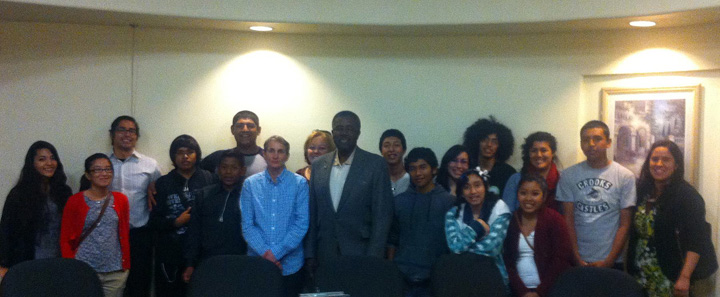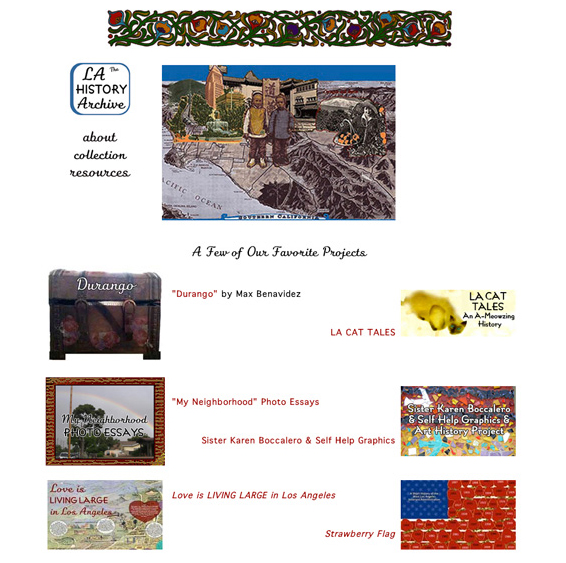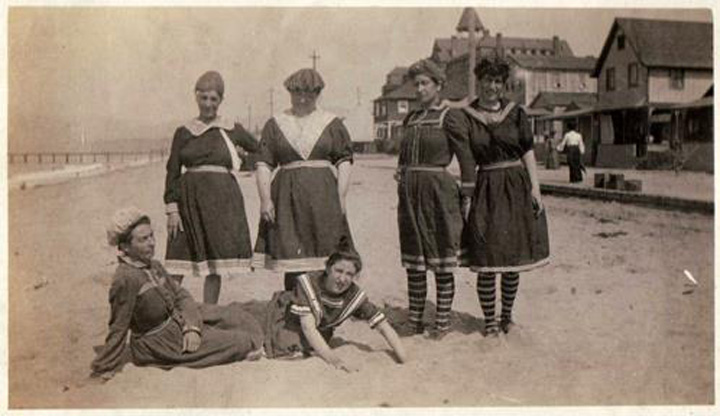By Sharon Sekhon
The Studio for Southern California History (Studio) is a nonprofit organization dedicated to critically chronicling and sharing the region's social history in order to foster sense of place. The Studio achieves its mission through participatory programming like our internship program with local college students, walking tours, oral histories and through various digital technologies including our online portfolio the LA History Archive and our free iPhone app "On this day in LA." The Studio's success is due to the strength of its collaborations with institutions and individuals dedicated to a critical understanding of place. I founded the Studio in 2006 with the ultimate goal to change California's standards for learning local history, which currently end at the 4th or 5th grade with an age-appropriate but very incomplete lesson on the Mission era (1769-1833). We have developed lesson plans (available on the LA History Archive) that integrate local history beyond the current standards.
Our programming itself provides examples of lessons and information to support research. Initially, the Studio maintained a gallery space in New Chinatown in Los Angeles but transitioned to a "Studio Without Walls" at the end of 2011 in order to survive the current economy and make best use of its funding. While the Studio does host occasional "pop-up" events, our most recent work has focused upon work outside of the traditional gallery setting. We published our research on Evergreen Cemetery in Boyle Heights in the book Evergreen in the City of Angels, available on Amazon.com. The Studio has created exhibits for different spaces including its former galleries and local organizations and when possible, these physical exhibits have an online component through the LA History Archive. Exhibits include, poetry, timelines, illustrated maps, community quilts and a contemporary dollhouse made in homage to 1972's "Womanhouse" – the first public "feminist" art exhibit held in Los Angeles. The LA History Archive also houses thousands of primary sources like ephemera and photographs through its "Collection."
The Studio has been privileged to partner with amazing people and organizations dedicated to developing an informed community. Highlights include our work for the Watts Gang Task Force, the Western Conservancy of Nursing History, Lauren Bon and the Metabolic Studio with the art project known as "Strawberry Flag" at the West Los Angeles Veterans Administration. This research provided for the hitherto recovery of unpublished history. Moreover, we have learned information that demands our acknowledgement – from gang and law enforcement violence in Watts; to the history of public health as it relates to the teaching and development of nursing; and the history of neglect and the homelessness currently plaguing 20,000 veterans in Los Angeles County. These histories provide substantive food for thought and often demand change by those of us documenting it.
The Studio has been privileged to work with museums in Los Angeles County due to curators and connections created by artists and friends. We were part of "EAT LACMA" at the Los Angeles County Museum of Art in the summer of 2010 through Fallen Fruit and our work on "Strawberry Flag." We were honored to be on a panel entitled "LA's Unsung Oracles" as part of Libros Schmibros at the Armand Hammer Museum in 2011 (with the assistance of Libros Schmibros' Colleen Juarretche and David Kipen and Allison Agsten – a dynamic person at the Hammer committed to public engagement), where we created a map of historic bookstores in Los Angeles and shared our work. In 2012 we were asked to host one of ShoeboxLA's amazing temporary installations that feature extraordinary Los Angeles locations and is curated by Paul W. Evans and Sophia Boo Allison. Their exhibits limit the art object size to fit a large shoebox on a tabletop. Additionally, two artists shared their work at separate Studio "pop-up!" events in Chinatown; Timothy Nolan's "Drift" employed mirrors and shadows to achieve new perspectives of place, and Joshua Levine played with hybridization, concepts of "normal," and memorialization by creating monuments that celebrated the abnormal and "freakish" in "Monumental."
The Studio's success has been due to the donated hours and moneys of artists and educators across the nation who may not or may have experience in public history but share a dedication to our mission. Alongside this amazing group of teachers and academics, the Studio has been blessed by the participation of artists (often teachers too) connected to Southern California. It is important for me to acknowledge that many people and institutions have contributed to the success of the Studio. Alongside these support systems are networks like Los Angeles As Subject, a consortium of archives and historical societies (and 75 Southern California museums), who has steadfastly supported our work and publicized our activities.
Currently, we are working with the Jerome Recreational Center and the Santa Ana Public Library on "The Raitt Street Chronicles." This project is an overview of the city's history through the oral histories of elders in the community and through the perspectives of high school students who are completing "My Neighborhood Photo Essays" (an ongoing challenge the Studio has for the public at large) and "Neighborhood Soundscapes" for the fall through Sounding Out!, a blog dedicated to sound studies led by Dr. Jenny Stoever-Ackerman at Binghamton University in New York.
 Raitt Street Chroniclers bask in the after glow of interviewing the first African American police officer hired in Orange County – Harlen Lambert and his gracious wife Sharon Lambert.
Raitt Street Chroniclers bask in the after glow of interviewing the first African American police officer hired in Orange County – Harlen Lambert and his gracious wife Sharon Lambert.
If you are interested in learning more about the Studio, please email us at thesocalstudio@gmail.com or "like" us on Facebook. Explore our websites to see if you are up to the "My Neighborhood Photo Essay" or other volunteer possibilities. The Studio welcomes financial contributions and donations are tax-deductible. In addition to our books on Amazon.com, we also sell "LA History Playing Cards" at the Library Store at the Central Library of the Los Angeles County Public Library. Each of our cards has a unique story about local history including people like Charles & Ray Eames, Biddy Mason, Sister Karen Boccalero, Ruben Salazar and dozens more. Our website is http://www.socalstudio.org.
Sharon Sekhon is the Founder and Executive Director of the Studio for Southern California History. She is also a Lecturer in American Studies at California State University Fullerton where her courses focus on American history.










Add new comment